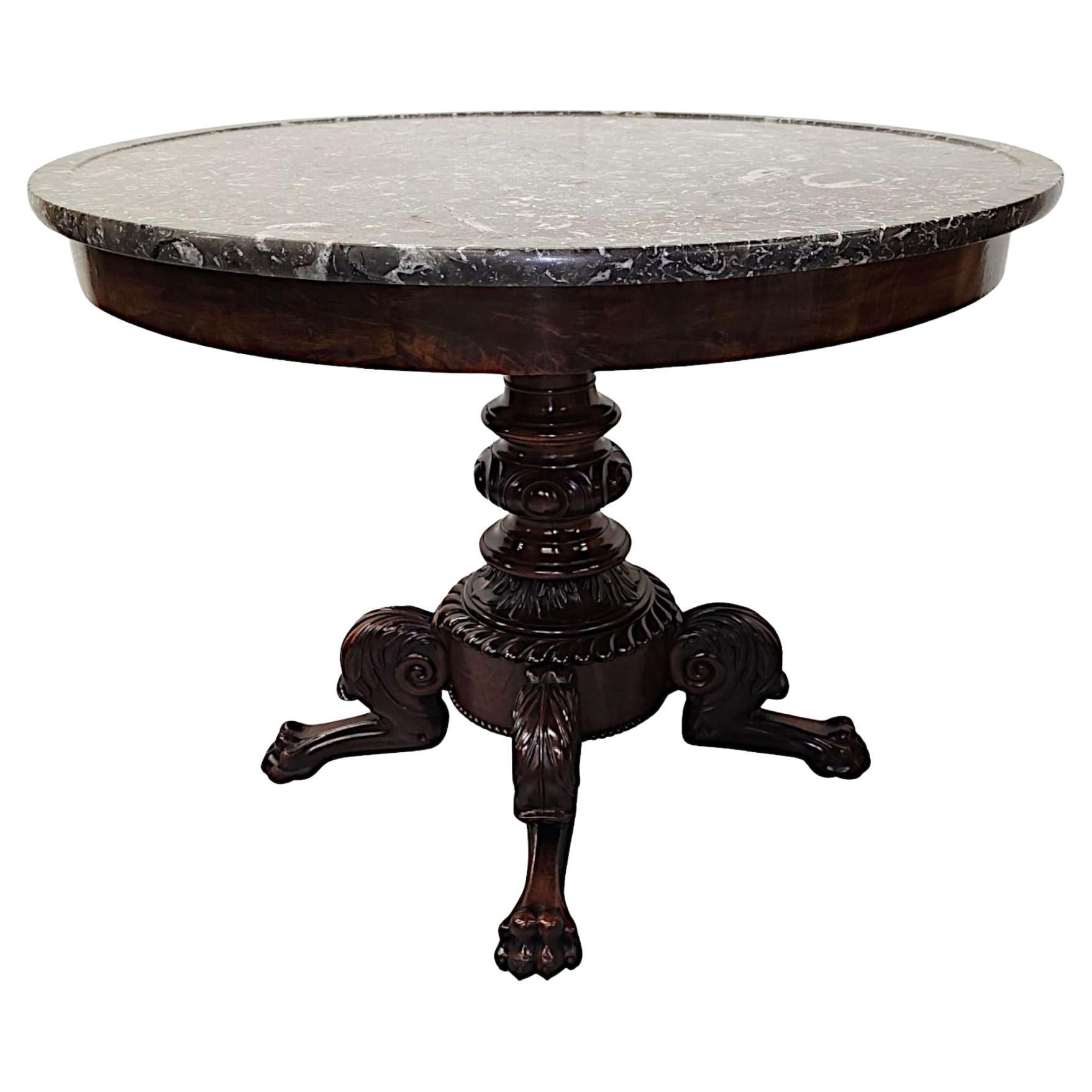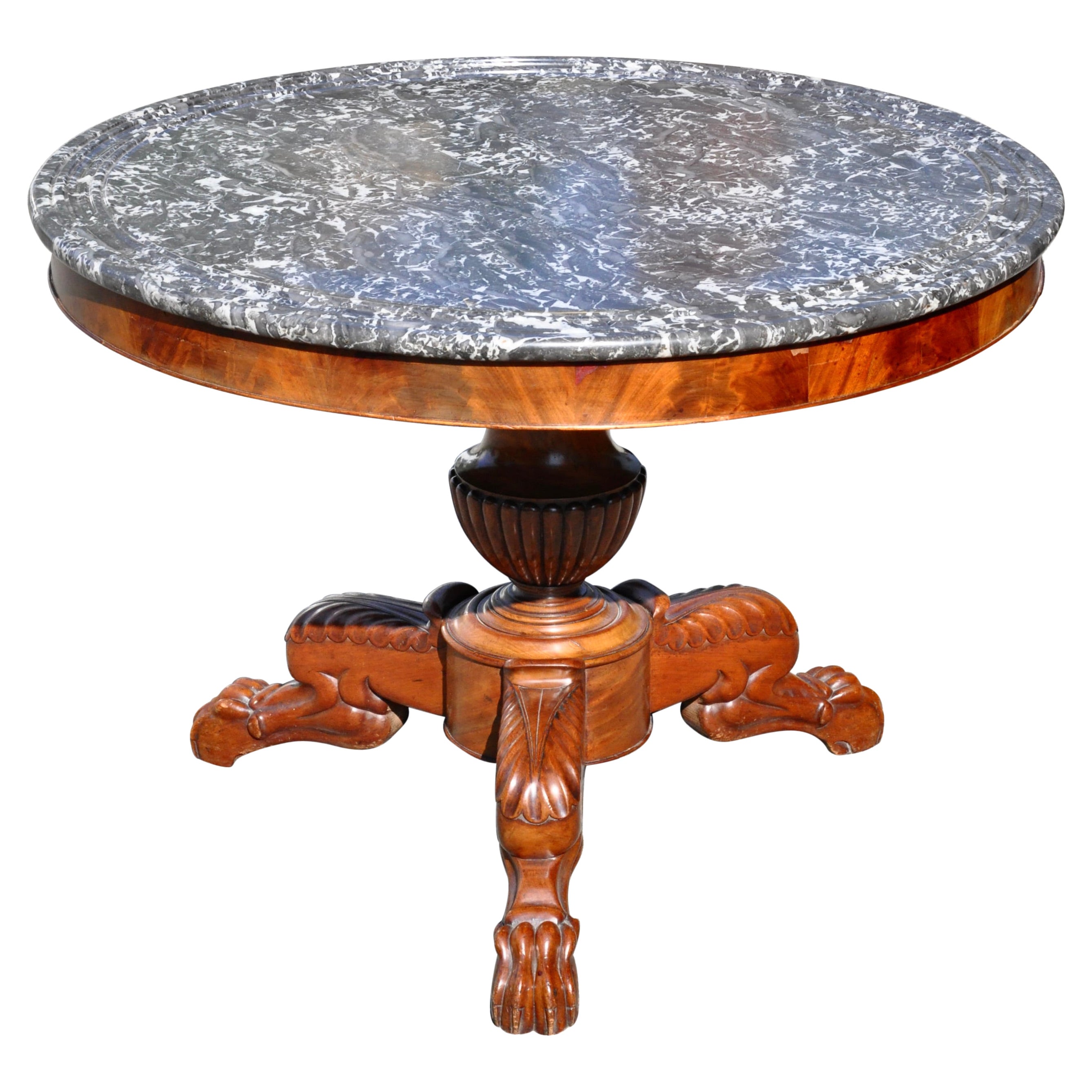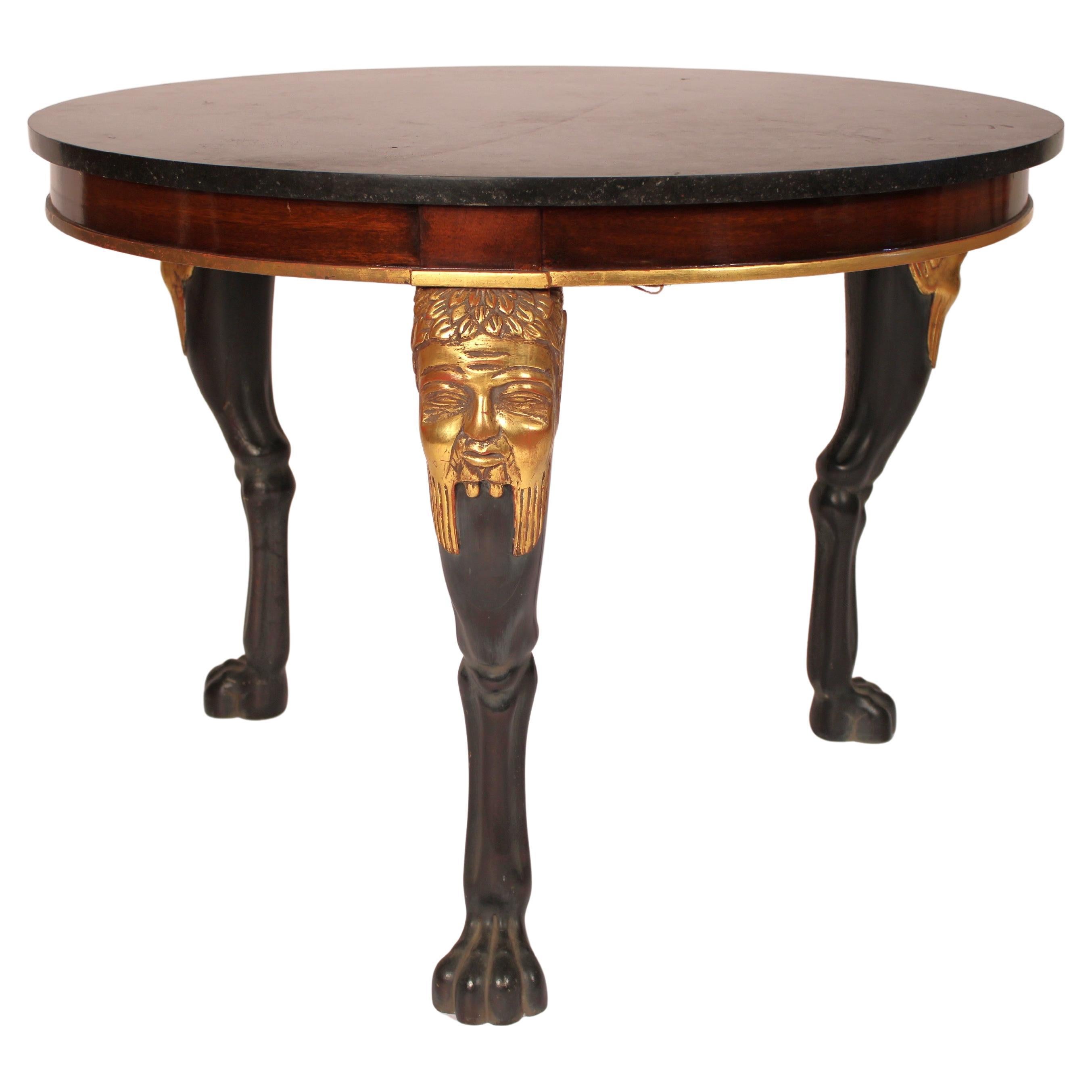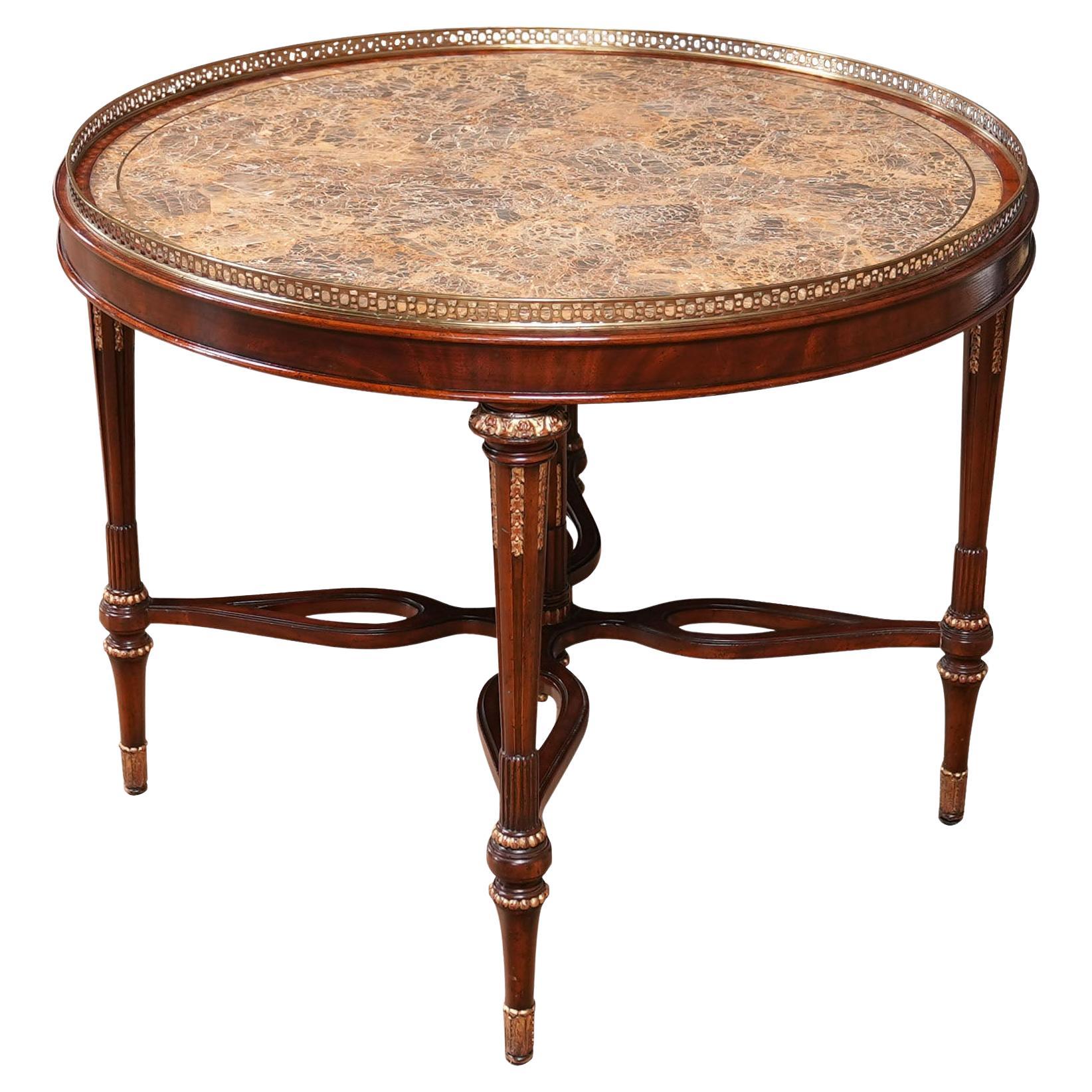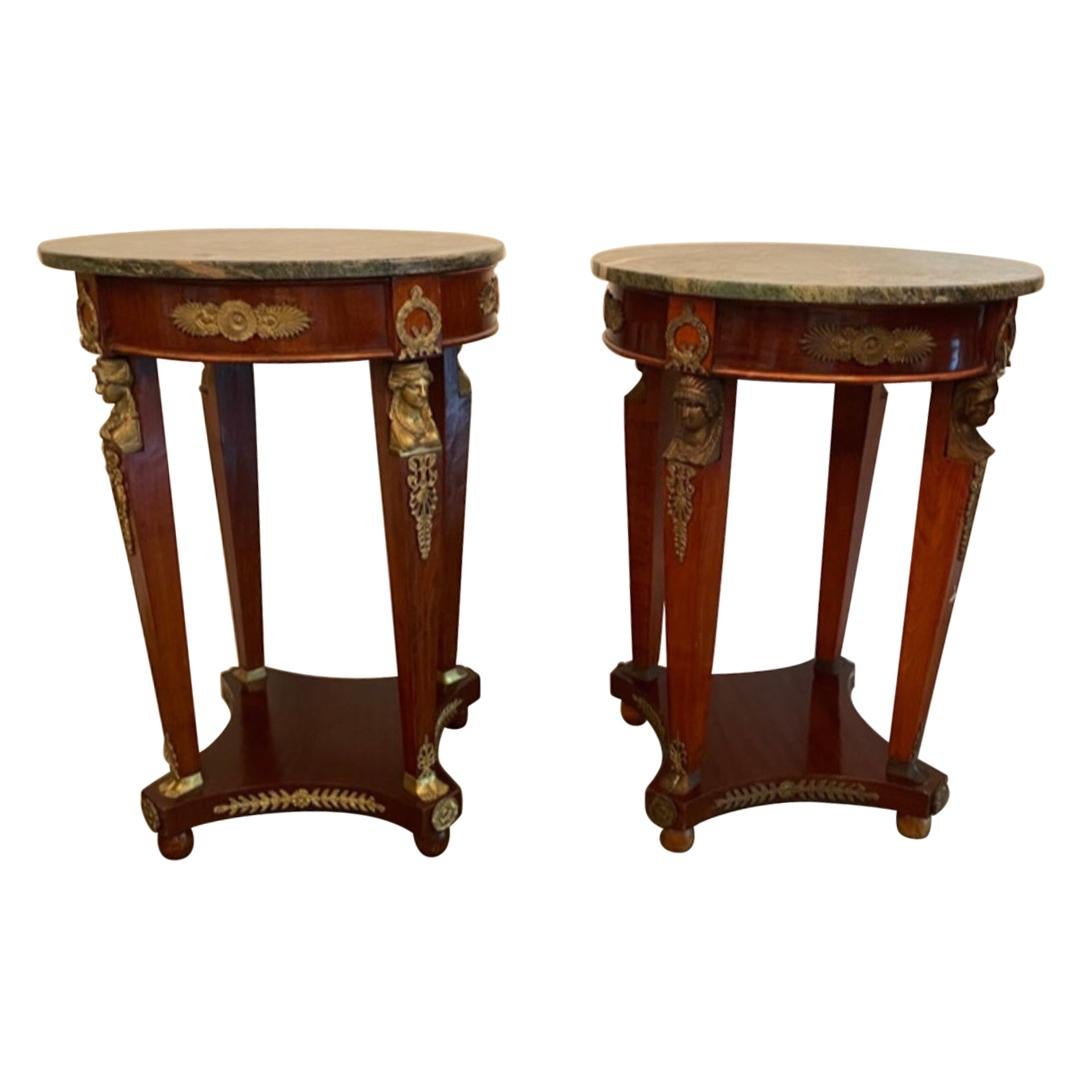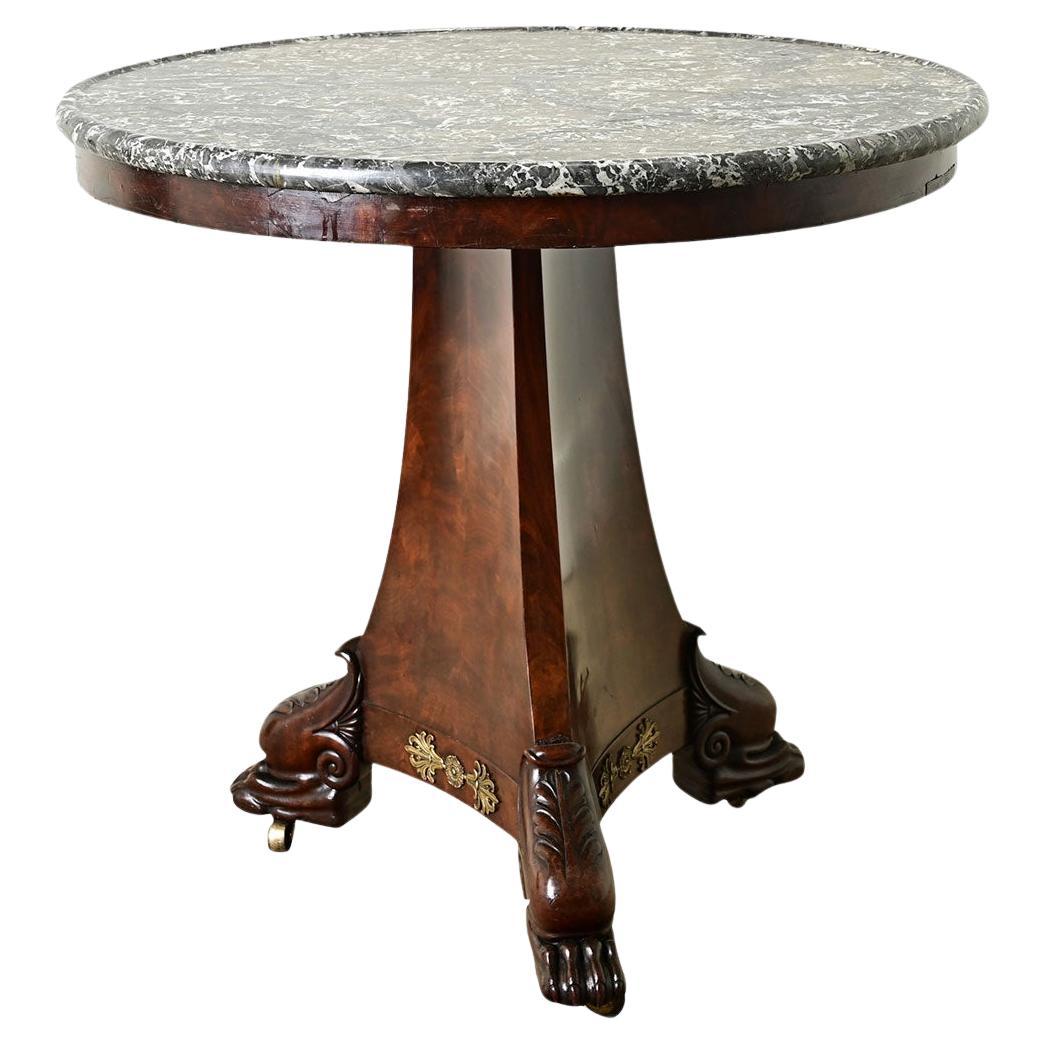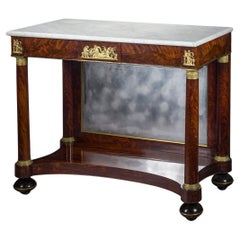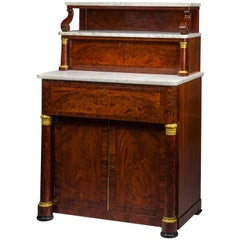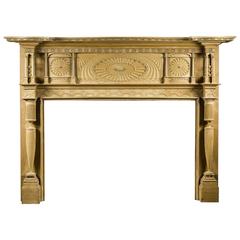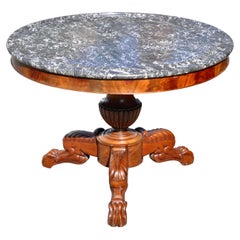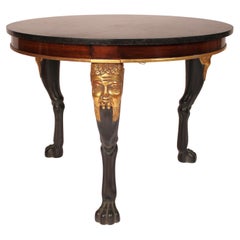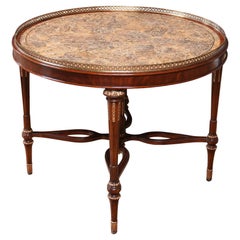Items Similar to Center Table with Scroll Legs, Paw Feet and Marble Tops
Want more images or videos?
Request additional images or videos from the seller
1 of 6
Center Table with Scroll Legs, Paw Feet and Marble Tops
$75,000
£57,497.02
€65,792.75
CA$105,991.90
A$115,209
CHF 61,673.23
MX$1,392,609.75
NOK 777,202.90
SEK 716,782.89
DKK 491,366.77
About the Item
Center Table, about 1818–20
Attributed to Thomas Seymour (1771–1848), working either for James Barker or for Isaac Vose & Son, with Thomas Wightman (1759–1827) as carver, Boston
Mahogany (secondary woods: ash and white pine), with brass castors and green marble top
29 3/4 in. high, 36 in. diameter
RECORDED: Robert D. Mussey, Jr., and Clark Pearce, “Classical Excellence in Boston: The Furniture of Isaac Vose, 1789–1825,” in Boston Furniture 1700–1900, (Boston: The Colonial Society of Massachusetts, 2016), p. 271 fig. 31 illus., 272 // Robert D. Mussey, Jr., and Clark Pearce, Rather Elegant Than Showy: The Classical Furniture of Isaac Vose, exhib. cat. (Boston: Massachusetts Historical Society, in association with David R. Godine, 2018), pp. 128–29, 130 fig. 148
EXHIBITED: Hirschl & Adler Galleries, New York, 2018–19, Augmenting the Canon: Recent Acquisitions of American Neo-Classical Decorative Arts, no. 42 not illustrated
In the years after Thomas Seymour closed his own shop in 1817, he worked first for Thomas Barker in the years 1817–19, and then for Isaac Vose, from 1819 until the closure of the Vose shop in 1825.
In their recent study of Vose and the later work of Thomas Seymour, Robert D. Mussey, Jr., and Clark Pearce assigned both this center table and a matching pier table to the Barker/Seymour shop or the Vose/Seymour association in the years 1818–20.
A large silhouette by Augustin-Amant-Constan-Fidèle Edouart (1789–1861) shows Daniel P. Parker and his family in the parlor of their home at 40 Beacon Street, Boston (Mussey and Peace, Rather Elegant, p. 129 figs. 147A and B). In the curved niche at the left, reflecting the bay on the front of the house, is a table that is either the pier table referenced above (collection of Hirschl & Adler Galleries, FAPG 20975D/2; ibid., p. 131 fig. 149), or another of identical or similar design. Also shown by Edouart is a center table with three identical scroll legs that sit on a platform that itself appears to be lifted off the carpet by casters. That table has a horizontally reeded skirt in which is inserted a drawer that appears to be outfitted as a desk.
The present center table is identical in design to the Parker center table, although it lacks the reeding on the skirt, and the drawer.
Mussey and Pearce originally surmised that the Parker center table was possibly an English import—“the table is likely English, with its apron panels of thick reeding” (Classical Excellence, p. 271)—that served as the inspiration for the present center table and the companion pier table. But subsequently they wrote that “it could have been either imported or made in Boston” (Rather Elegant, p. 128), and based upon a whole group of furniture of related design, including a monumental side table made for Parker’s next-door neighbor, Nathan Appleton (collection of Historic New England, Boston; ibid., p. 107 fig. 119), there is little reason to look for its origin outside of Boston.
Mussey and Pearce also ponder the possibility that the present table may once have had a platform like that of the Parker table. But with its height of 29 3/4 inches, including its marble top, it would stand about 33 inches in height if it originally had a platform, and whereas 28 1/2–30 1/2 is the standard range of the height for center tables of this period, a height of about 33 inches falls substantially out of the norm. Further, a careful examination of the bottoms of the three legs reveals that they were originally hollowed out so that the casters were largely housed within the legs, adding only about 1/2-inch to the height of the table. (In their catalogue of the Vose exhibition, Mussey and Pearce erroneously give the height of the table as 36 inches [p. 130, fig 148]).
The present center table was supplied with a replacement marble top for its appearance in the Vose exhibition because it was judged at the time that the overhang of the marble top that had descended with it was too large. But an examination of the top that originally came with the table reveals substantial discoloration (“witness”) around the edge, which confirms that it was indeed the original top. It is likely not coincidental that the related pier table has a matching marble top, which also appears on the Appleton side table, signaling either a single commission, or a shop with a preference for a specific type of marble.
The carving on the table is by Thomas Wightman, who had a long association with Seymour, first when he ran his own shop, and later during his years with Barker and then Vose.
- Attributed to:Thomas Seymour (Cabinetmaker)
- Dimensions:Height: 29.75 in (75.57 cm)Diameter: 36 in (91.44 cm)
- Style:American Classical (Of the Period)
- Materials and Techniques:
- Place of Origin:
- Period:
- Date of Manufacture:about 1818-1820
- Condition:Replacements made: Corner blocks are likely replacements. Refinished. Wear consistent with age and use. CONDITION: Excellent. The mahogany surfaces have been cleaned and French polished. The corner blocks are likely replacements.
- Seller Location:New York, NY
- Reference Number:Seller: FAPG 21089D.0071stDibs: LU903228816302
About the Seller
No Reviews Yet
Recognized Seller
These prestigious sellers are industry leaders and represent the highest echelon for item quality and design.
Established in 1952
1stDibs seller since 2010
Associations
Art Dealers Association of America
- ShippingRetrieving quote...Shipping from: New York, NY
- Return Policy
More From This Seller
View AllPier Table
Located in New York, NY
One of the signature forms of the Neo-Classical period, the pier (or console) table received its name from its typical use against the wall, or pier, between two windows. Pier tables...
Category
Antique 1810s American Neoclassical Tables
Materials
Marble, Brass, Bronze, Lead
$65,000
Card Table in the Rococo Taste
By Charles A. Baudoine
Located in New York, NY
RECORDED: cf. Anna Tobin D’Ambrosio, ed., Masterpieces of American Furniture from the Munson-Williams-Proctor Institute (Syracuse University Press, Utica, New York, 1999), pp. 85, 86, 87 illus. the Munson-Williams-Proctor tables // cf. The Metropolitan Museum of Art, New York, 19th Century America–Furniture and Other Decorative Arts (1970), exhib. cat., [n.p.] no.133
This table is identical to a pair of card tables bearing the stenciled label of Charles A. Baudouine of 335 Broadway, New York, which were acquired by James and Helen Munson Williams of Utica, New York, in May 1852 for their home, Fountain Elms, which is where they remain today as part of the Munson-Williams-Proctor Art Institute collection. The Williams tables were billed as “1 Rosewood Multiform Table” at $160 for the pair, and they were indeed “multiform” in that they could be used separately and folded as a pair of console tables, opened as a pair of card tables, or joined together as a center table. The present table varies essentially in the fact that it does not include the mechanism that would have allowed it to be attached to another to form a center table.
Of French descent, Baudouine was born in New York in 1808. He made his debut as a cabinetmaker in the New York directory of 1829/30, where he is listed at 508 Pearl Street. By 1839/40 he relocated to Broadway, where he remained in business at various addresses until about 1854. A sense of the scale of Baudouine’s operation is given by German immigrant cabinetmaker Ernest Hagen...
Category
Antique Mid-19th Century North American Rococo Revival Card Tables and T...
Materials
Wood, Rosewood
Butler's Desk and Etagére, New York, Possibly Duncan Phyfe
By Duncan Phyfe
Located in New York, NY
Butler’s Desk and Etagére, circa 1825
New York, possibly by Duncan Phyfe
Mahogany (secondary woods: mahogany, pine, poplar), with ormolu mounts, marble,...
Category
Antique 1820s American Neoclassical Cabinets
Materials
Mahogany
Fan-Carved Wood Mantel in the Federal Taste
Located in New York, NY
New York,
Fan-carved mantel in the Federal taste, circa 1812
Pine
Measures: 66 1/4 in. high, 90 3/8 in. wide, 13 1/4 in. deep
Within the genre of carved rather than plasterwork mantels of the Federal Period, no example that has come to light is more perfectly designed or more carefully wrought than the present one, which is an amazing symphony of fans, urns, beads, and other Neo-Classical devices, all ultimately influenced by the plasterwork designs of the English architects Robert (1728–1792) and James (1732–1794) Adam.
Of a type that proliferated in the area bounded by the northern New Jersey counties of Bergen and Passaic, the Hudson Valley, and western Long Island, the mantel is representative of work that flourished in the first couple of decades of the 19th century. While most of the woodwork of this style that has survived is found in interiors, various examples of exterior doors and other trim have been noted, but most examples have disappeared as a result, variously, of natural deterioration and purposeful demolition in anticipation of development.
Although considerably larger in scale and more elaborate in ornament than a mantel that has been in the collection of the Brooklyn Museum since 1944 (acc. no. 44.55; photograph in Hirschl & Adler archives), the present mantel is so close in style and conception to that example that it likely originated in the same house.
The Brooklyn mantel is documented as having been removed from a house built by Judge Isaac Terhune (1762–1837), an eminent lawyer and judge. The house was situated on King’s Highway, at the corner of Mansfield Place, at the edge of South Greenfield, a village in northern Gravesend, Brooklyn. A photograph of the house, taken by the German e´migre´ photographer, Eugene Armbruster (1865–1933), is in the collection of the New-York Historical Society.
Terhune is ultimately descended from the Dutch-Huguenot e´migre´ Albert Albertson Terhunen, who died in Flatlands, Brooklyn, in 1685.The family eventually spread out through New Amsterdam, Long Island, and Bergen County, New Jersey. Terhune’s great-grandson, also Albert (1715–1806), left a sizable estate to his six surviving children, including his second child and second son, Isaac.
Judge Terhune lived in the house until his death in 1837, at which time, according to an article in The New York Times for November 27, 1910, he, having died without issue, “left the White Frame Mansion with its exquisitely carved doorway, beautiful mantels, and other interior adornments to his brother John” (Part Six, p. 11).
The article continues:
After the latter’s death, the house and its estate of about 70 acres passed through several owners, eventually being purchased in 1853 by Benjamin G. Hitchings [1813–1893].
The house next passed to Benjamin’s son, Hector, who had been born in the house, and then lived there for 25 years. He sold it in 1910 in partial payment for a Manhattan apartment house. After thus having been sold to a real estate developer, the Hitchings property was subdivided into Hitchings Homestead. The house survived until about 1928, at which time it was razed and a Deco-style apartment house with the address 2301 Kings Highway was constructed on the site and occupied in 1935.
By 1910, the fate of the house, in an area of Brooklyn that was being rapidly developed, was becoming obvious. The Times article reported:
The house has been well kept up, but fearing lest the hand of time or vandals might deal harshly with some of its choice bits of carving, Mr. Hitchings removed a few years ago a few beautifully carved wood mantels...
Category
Antique 1810s American Neoclassical Fireplaces and Mantels
Materials
Wood
Pair Side Chairs with Lyre Back
Located in New York, NY
“I know of no other chair like the single [sic] ‘lyre back’ one. . . . I certainly recognize it as a Boston chair considering all the individual elements, but the combination is particularly elegant.” So wrote noted scholar of Boston furniture Page Talbott when a set of four chairs of this design originally surfaced in the 1980s. Although the existence of four chairs in a specific pattern might imply that the chairs were originally part of a larger set, no additional chairs of this form have appeared in the intervening years.
The lyre became a popular motif during the Neo-Classical period, and is frequently encountered as the back splat of klismos chairs, in no example more familiar than in a group of Duncan Phyfe chairs...
Category
Antique 1820s American Neoclassical Chairs
Materials
Mahogany
$30,000 / set
Small Settee in the Neoclassical Taste
Located in New York, NY
Small Settee in the neoclassical taste
Boston, Massachusetts (active 1804–17), about 1810
Mahogany (secondary woods: ash)
Measures: 35 1/8 in. high, 59 3/4 in. long, 19 1/8 in. deep
Although the diminutive scale of this settee places it in a unique category, the piece itself partakes of a vocabulary that is common in Boston furniture of the Late Federal period. Its sabre legs, for example, as seen straight on from the left and right ends, are closely related to the legs, as seen from the front, on a group of chairs of undisputed Boston origin, including a spectacular armchair with scrolled arms (see Stuart P. Feld, Boston in the Age of Neo-Classicism, 1810–1840, exhib. cat. [New York: Hirschl & Adler Galleries, 1999], p. 37 no. 6 illus. in color), as well as a number of side chairs, including a set made for Nathan Appleton (see Page Talbott, “Boston Empire Furniture, Part I,” The Magazine Antiques, CVII [May 1975], p. 887 fig. 12). In all, the legs are ornamented with two bold, somewhat flattened reeds set between corner beads, a pattern which is repeated here on the front and end seat rails as well. The superb quality of the piece is further demonstrated in the finely drawn profile of the arms, as well as the delicately bulbous surface of the fronts of the arms and legs. As in the best of the related chairs, the sabre legs end in delicately carved paw feet. The added refinement of the beautifully carved rosettes at both the fronts and backs of the arms suggests that the piece may have been designed to be used in the round.
Stylistically harmonious with these pieces is also a group of larger sofas with frontally set sabre legs and scrolled arms (see Page Talbott, “Seating Furniture in Boston, 1810–1835,” The Magazine Antiques, CXXXIX [May 1991], p. 963 pl. 11) that represent an indigenously Boston form. Although none of the furniture in this group has been effectively attributed, they can certainly be related to various Boston card tables...
Category
Antique Early 19th Century American Neoclassical Settees
Materials
Wood
You May Also Like
A Very Rare Large 19th Century Marble Top Centre Table With Claw Foot
Located in Dublin, IE
A very rare 19th Century well figured mahogany marble top centre table of grand proportions, exceptional quality and finely hand carved with beautifully rich patination and grain. T...
Category
Antique 19th Century French Center Tables
Materials
Marble
Early 19th Century French Marble Top Center Table or Gueridon
Located in Essex, MA
Period early 19th century marble top mahogany center table. Baluster shaft with original marble top and paw lion legs.
Category
Antique Early 19th Century French Charles X Center Tables
Materials
Marble
Neo Classical Style Marble Top Center Table
Located in Laguna Beach, CA
Neo classical style gilt wood and lacquer center table with a marble top, late 20th century. With a round marble top, mahogany frieze with gold leaf on lower border, 3 legs with carv...
Category
Late 20th Century Unknown Neoclassical Center Tables
Materials
Gold Leaf
NVIN0526 Vintage Marble Top Center Table
Located in Annville, PA
A great quality piece of furniture this Vintage Marble Top Center Table will be the focal point of any area in your home. From the beautiful marble top, surrounded by a brass gallery...
Category
1990s North American Renaissance Center Tables
Materials
Marble
Marble Top Center Table
Located in Dallas, TX
Marble top center table with applied bronze.
Category
Vintage 1930s Unknown American Classical Center Tables
Materials
Bronze
$8,624 Sale Price / set
20% Off
French 19th Century Restauration Center Table
Located in Baton Rouge, LA
A handsome French Restauration center table made of burl mahogany. The original Saint Anne marble top rests above a three-sided concave mahogany base with gilt bronze ormolu. The ori...
Category
Antique 19th Century French Restauration Gueridon
Materials
Marble, Brass
More Ways To Browse
Table Skirt
Pier Table Antique
Robert Thomas
Scroll Leg Table
36 Inch Table
Antique American Marble Table
Boston Mahogany
Used Furniture In Boston
Mahogany Marble American Table
Scroll Leg Wood Table
Isaac Vose
Eglomise Center Table
Foyer Marble Top
Georgian Drum Table
Irish Silver Table
Martin Library Martin Brockett
Portuguese Library Table
Spanish Colonial Round Table
